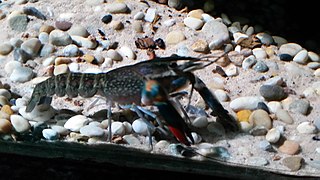- Extinct in the wild (EW): 2 species
- Critically endangered (CR): 393 species
- Endangered (EN): 626 species
- Vulnerable (VU): 1,081 species
- Near threatened (NT, LR/cd): 398 species
- Least concern (LC): 4,080 species
- Data deficient (DD): 2,890 species
- 9470 extant species have been evaluated
- 6580 of those are fully assessed [lower-alpha 1]
- 4478 are not threatened at present [lower-alpha 2]
- 2100 to 4990 are threatened [lower-alpha 3]
- 83 to 169 are extinct or extinct in the wild:
- 81 extinct (EX) species [lower-alpha 4]
- 2 extinct in the wild (EW)
- 86 possibly extinct [CR(PE)]
- 0 possibly extinct in the wild [CR(PEW)]
- ↑ excludes data deficient evaluations.
- ↑ NT, LR/cd, LC.
- ↑ Threatened comprises CR, EN and VU. Upper estimate additionally includes DD.
- ↑ Chart omits extinct (EX) species

In July 2016, the International Union for Conservation of Nature (IUCN) listed 390 near threatened arthropod species. [1] Of all evaluated arthropod species, 4.1% are listed as near threatened. The IUCN also lists six arthropod subspecies as near threatened.
Contents
- Arachnids
- Branchiopoda
- Entognatha
- Maxillopoda
- Malacostracans
- Decapods
- Insects
- Hemiptera
- Orthoptera
- Hymenoptera
- Lepidoptera
- Beetles
- Odonata
- See also
- References
No subpopulations of arthropods have been evaluated by the IUCN.
This is a complete list of near threatened arthropod species and subspecies as evaluated by the IUCN.

